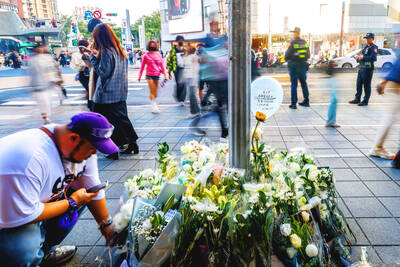A civic group urged the government yesterday to take action to dissuade children and teenagers from using mobile phones because of health concerns.
The Taiwan Electromagnetic Radiation Hazard Protection and Control Association (TEPCA) presented results of a survey on child and teenager cellphone use, along with information about the levels of electromagnetic radiation produced by cellphones marketed in Taiwan.
The survey, conducted last month and this month among children and teens aged six to 18, found that 34.4 percent of polled elementary school students, 67 percent of junior high school students and 89.6 percent of senior high school students used cellphones.
Based on the survey, the association, a non-governmental organization promoting legislation to restrict the impact of electromagnetic radiation on public health, estimated that around 2.2 million children and teenagers nationwide have their own mobile phones.
The survey also found that the older respondents talked longer on the phone, estimating that 390,000 young cellphone users speak on the phone for at least five minutes per call on average and 170,000 speak for more than 10 minutes per call.
Meanwhile, tests on the electromagnetic radiation levels of 33 types of mobile phones showed that more than 60 percent of the handsets emitted electromagnetic radiation 1 million times higher than the background level, or general exposure level to electromagnetic fields.
The association said that many industrialized countries have advised children, teenagers and pregnant women to refrain from using cellphones.

SHIPS, TRAINS AND AUTOMOBILES: The ministry has announced changes to varied transportation industries taking effect soon, with a number of effects for passengers Beginning next month, the post office is canceling signature upon delivery and written inquiry services for international registered small packets in accordance with the new policy of the Universal Postal Union, the Ministry of Transportation and Communications said yesterday. The new policy does not apply to packets that are to be delivered to China, the ministry said. Senders of international registered small packets would receive a NT$10 rebate on postage if the packets are sent from Jan. 1 to March 31, it added. The ministry said that three other policies are also scheduled to take effect next month. International cruise ship operators

NUMBERS IMBALANCE: More than 4 million Taiwanese have visited China this year, while only about half a million Chinese have visited here Beijing has yet to respond to Taiwan’s requests for negotiation over matters related to the recovery of cross-strait tourism, the Tourism Administration said yesterday. Taiwan’s tourism authority issued the statement after Chinese-language daily the China Times reported yesterday that the government’s policy of banning group tours to China does not stop Taiwanese from visiting the country. As of October, more than 4.2 million had traveled to China this year, exceeding last year. Beijing estimated the number of Taiwanese tourists in China could reach 4.5 million this year. By contrast, only 500,000 Chinese tourists are expected in Taiwan, the report said. The report

HORROR STORIES: One victim recounted not realizing they had been stabbed and seeing people bleeding, while another recalled breaking down in tears after fleeing A man on Friday died after he tried to fight the knife-wielding suspect who went on a stabbing spree near two of Taipei’s busiest metro stations, Taipei Mayor Chiang Wan-an (蔣萬安) said. The 57-year-old man, identified by his family name, Yu (余), encountered the suspect at Exit M7 of Taipei Main Station and immediately tried to stop him, but was fatally wounded and later died, Chiang said, calling the incident “heartbreaking.” Yu’s family would receive at least NT$5 million (US$158,584) in compensation through the Taipei Rapid Transit Corp’s (TRTC) insurance coverage, he said after convening an emergency security response meeting yesterday morning. National

The Forestry and Nature Conservation Agency yesterday launched a gift box to market honey “certified by a Formosan black bear” in appreciation of a beekeeper’s amicable interaction with a honey-thieving bear. Beekeeper Chih Ming-chen (池明鎮) in January inspected his bee farm in Hualien County’s Jhuosi Township (卓溪) and found that more than 20 beehives had been destroyed and many hives were eaten, with bear droppings and paw prints near the destroyed hives, the agency said. Chih returned to the farm to move the remaining beehives away that evening when he encountered a Formosan black bear only 20m away, the agency said. The bear